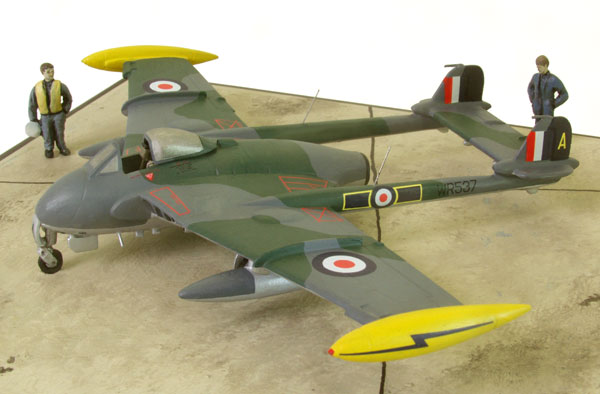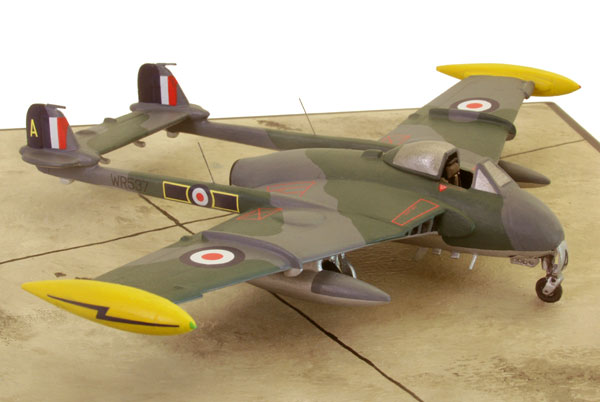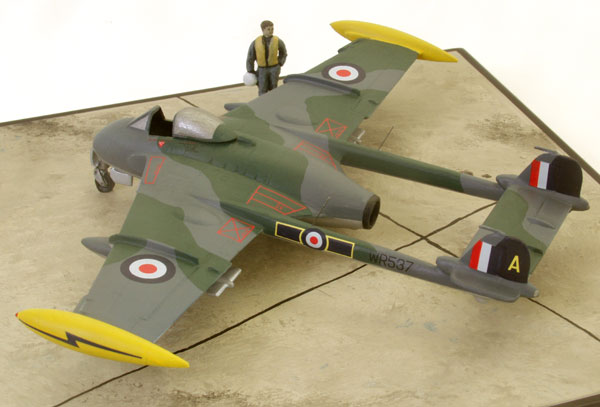de Havilland Venom FB 4
de Havilland Venom FB 4 WR537 A 28 Squadron,
Kai Tak, Hong Kong June 1962
One of the concerns with early British gas turbine engines was a potential loss of power with long intakes and jet pipes; a way to combat this was to keep both as short as possible, and this was kept in mind when de Havilland designers were working on their first jet aircraft, the DH.100 jet fighter designed around a Halford centrifugal-flow jet engine. The intakes were sited in the wing roots to be as close to the engine as possible, and rather than having a rear fuselage through which the jet exhaust would pass the twin booms either side of the central body permitted a very short efflux. Known initially as the “Spider Crab” the aircraft was officially named Vampire, and its development included being fitted with more powerful de Havilland Goblin engines and airframe modifications to enhance performance.
In 1947 TG278, an early Mk.1, was fitted with a de Havilland Ghost, an enlarged development of the Goblin with almost fifty percent more thrust than its predecessor, and with this extra power and extended wing tips giving an additional ten foot span it set an altitude record of 59,446 feet, flown by DH’s chief test pilot Gp. Capt. John Cunningham. Recognising the potential of this combination, the Air Ministry Operational Requirement OR.277 resulted in Specification F.15/49, this being issued to de Havilland calling for a thin-wing version of their basic design; known originally as the Vampire FB.8, it was decided that the changes warranted a new type number and the DH.112 was also given the new name of Venom. The Ghost fitted in to the original fuselage without any visible external change; the major visible differences were the wing with a leading edge sweep of 17 degrees and a pair of 75 gallon tip tanks that were a virtual permanent fixture in service. One result of these changes was a considerably improved high level performance, but its allocated role was that of ground attack, indicated by its designation of FB.1.
The airframe was also developed as a two-seat night fighter, the NF.2 and NF.3 and their naval equivalents; the RAF single-seaters were only used outside the United Kingdom, notably in RAF Germany with the Second Tactical Air Force and in Near, Middle and Far East Squadrons. 28 Squadron was allocated to the defence of Hong Kong, with Venom FB.1s replacing its Vampires in February 1956; these were in turn traded in for the more developed Venom FB 4 in November 1959. This mark sported larger rudders – described as “kidney-shaped” – with tailplane extensions outboard of the fins, and power-operated ailerons, with late production aircraft having Martin-Baker ejection seats, a facility not previously available in Venoms. The original order for this mark was for 400, but in the event only 150 were built, production being shared between de Havilland at Chester and Hatfield, Marshalls at Cambridge and Faireys at Ringway, the last responsible for WR537, one of the last six to be built. 28 Squadron’s Venom FB 4s were the last single-seaters in front-line RAF service, the final flight being by WR539/F on 27 June 1962 when the Venoms were replaced by Hunters.
28 Squadron has spent most of its operational service in the East, beginning in 1920 being re-numbered from 114 Squadron at Ambala in India equipped with the ubiquitous Bristol Fighter, flying these until they were replaced by Wapitis in 1931. Their first monoplanes were Hurricanes, from 1942 until almost the end of the war against Japan; almost all of this time was spent in India, but they finished the war with Spitfires in Burma. They arrived in Hong Kong in May 1949 flying the Spitfire FR.18, based either at Sek Kong or Kai Tak until disbanding as a fighter squadron flying Hunters in January 1967. Just over a year later the squadron reformed at Kai Tak with the Whirlwind HAR.10, this being followed four years later by Wessex HC.2s. It was disbanded once more at Kai Tak in June 1997, but the rotary-wing connection continues, although now UK-based; in 2001 it was reformed at Benson with the Merlin HC.3, with detachments currently returned to the East for operations in Afghanistan.
Scale 1:72 Wingspan 6.95″ (176 mm)
Base size 7.71″ (196 mm) square (No. 5)
Weight not including base 9.9 ozs (279 grams) Limited edition of 25 only
SOLD OUT




